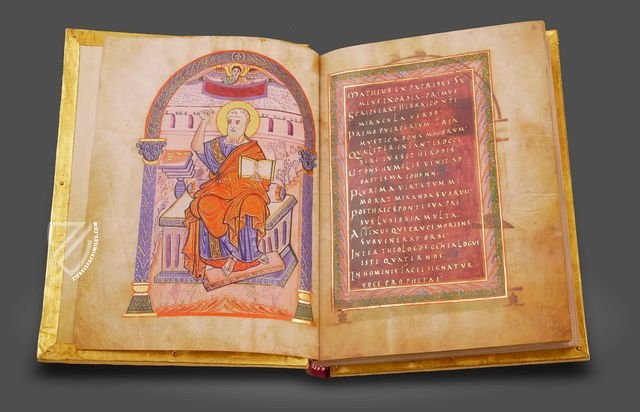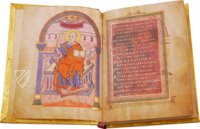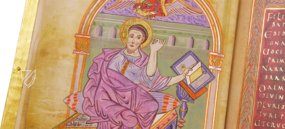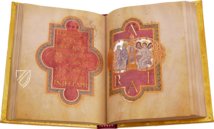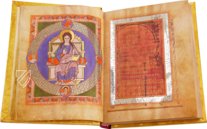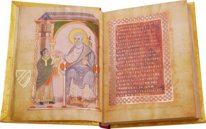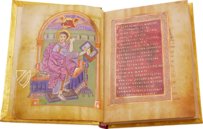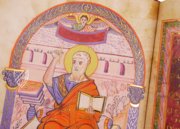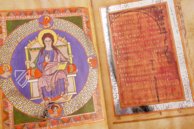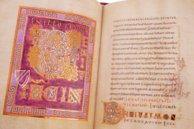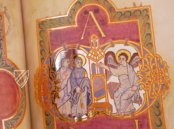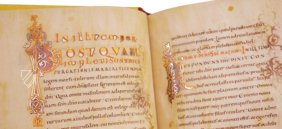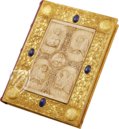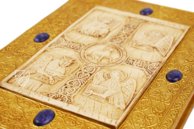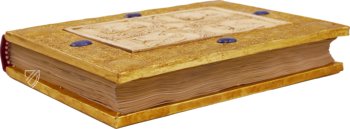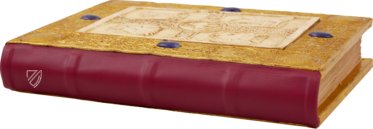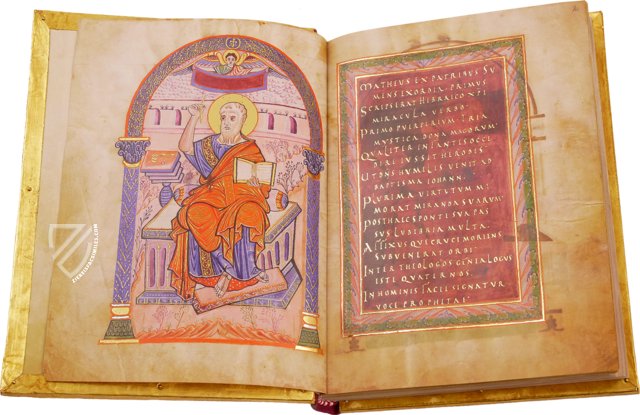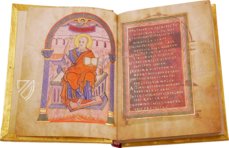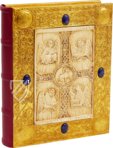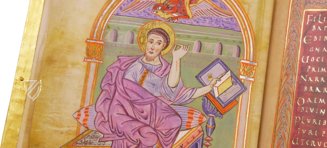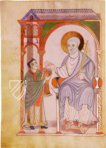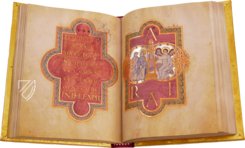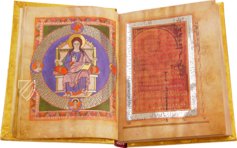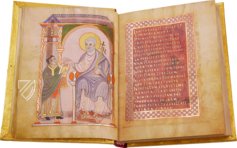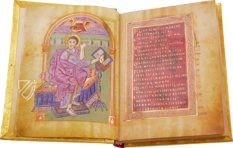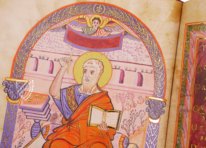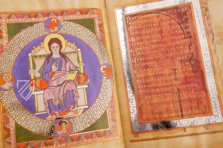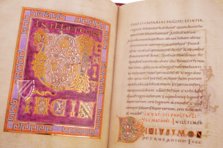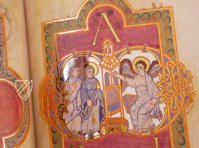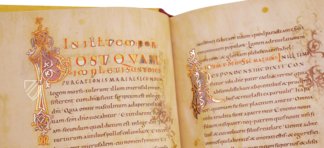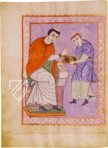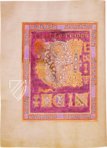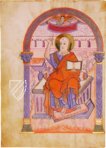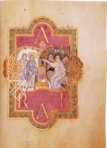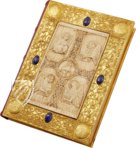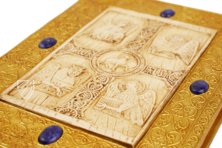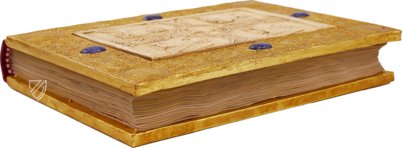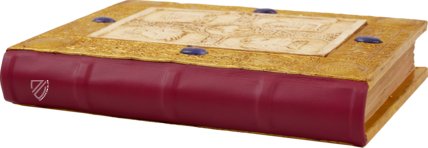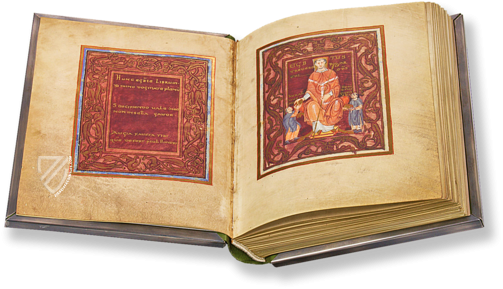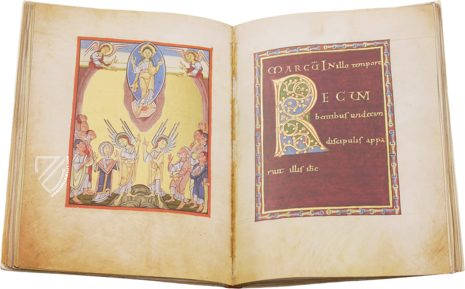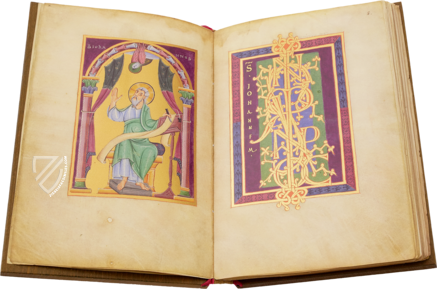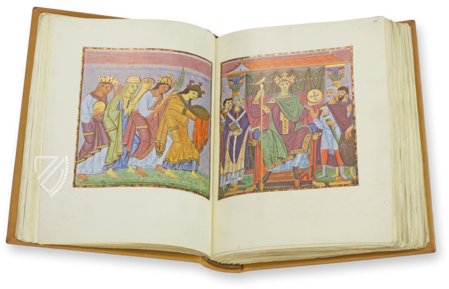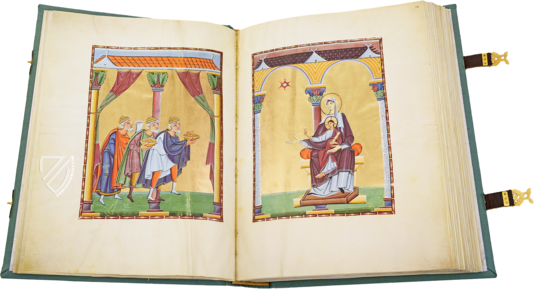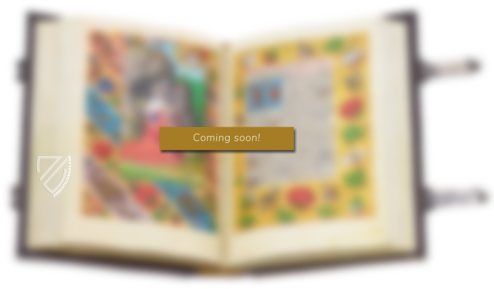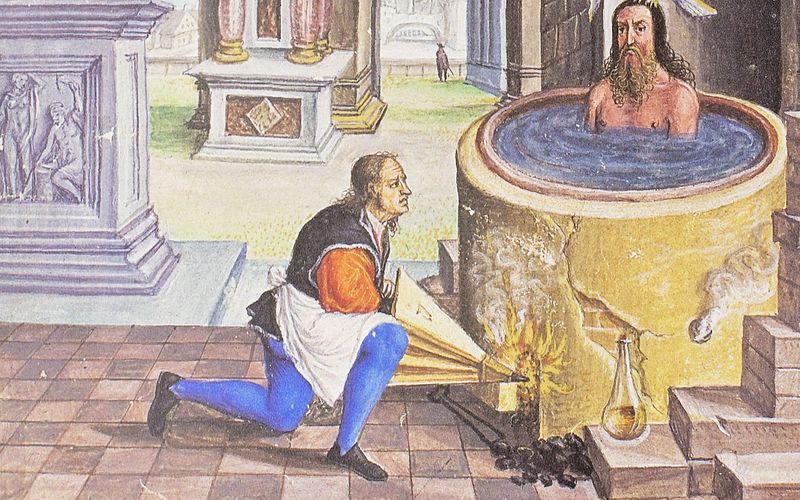Gero-Codex
(over 10,000€)
The Gero Codex, completed around the year 969 on the world-famous island of Reichenau, is probably the most important and also the oldest work of Reichenau illumination. This unique manuscript was created by the scribe Anno for the influential Archbishop Gero of Cologne, who had himself immortalized in no less than two dedication images. With a total of 24 magnificent full-page miniatures and precious decorative pages in purple and gold, as well as its countless artistically designed and partly historiated initials in gold and silver, the Gero Codex is a manuscript of outstanding artistic and historical value and is a beautiful testimony to the development from Carolingian to Ottonian book art. It is no coincidence that the Gero Codex, due to its outstanding status, was included by UNESCO as one of the few medieval manuscripts in the select circle of the Memory of the World Programme. Today, the magnificent codex is preserved in the Darmstadt University and State Library.
Gero-Codex
The Gero Codex is simultaneously the oldest surviving specimen from the famous scriptorium of Reichenau Abbey and also one of the most outstanding examples of Ottonian illumination. It is a magnificent Gospel Book designed for liturgical use, presumably in Cologne Cathedral, and is decorated with the most expensive paints, inks, and dyes as well as being illuminated with gold and silver leaf. More than any other Reichenau manuscript, it transmitted the Carolingian tradition of book art, which still maintained many forms from Late Antiquity, but also established a new artistic tradition in the scriptorium there that would influence future artistic movements. It was created ca. 969 by the monk Anno at the behest of Archbishop Gero of Cologne (ca. 900–976), who states in the dedication poem that he hopes Saint Peter will open the Pearly Gates for him in thanks for the splendid gift.
An Ottonian Masterpiece
Firstly, the manuscript was created only with the most expensive materials, beginning with its 176 leaves of fine parchment. The text is neatly written in Carolingian miniscule with frontispieces written in Capitalis rustica. Foremost among the artistic furnishings of the manuscript are the seven full-page miniatures, a full-page historiated initial of the Three Marys at the Tomb, and four elaborate full-page initials reminiscent of Insular illumination. Furthermore, there are hundreds of smaller yet still elaborate initials and marginal décor in gold, silver, and sumptuous colors. Decorative text pages written in gold ink with purple-dyed backgrounds and intricate frames with various patterns appear opposite of the full-page miniatures and three additional incipit pages appear in the text. The beholder is simply overwhelmed by the sheer magnificence of this manuscript’s adornment.
Similarites with the Lorsch Gospels
The four Evangelist portraits and the Maiestas Domini that appear at the beginning of the manuscript closely resemble those found in the Lorsch Gospels, which predates it by more than half a century. However, it is not known if the monk Anno personally saw this manuscript or if they are both based on the same Carolingian model. In contrast to the Lorsch Gospels, these miniatures are simpler but more monumental, perspective and nature are deemphasized, and the figures appear larger in comparison to the architectural elements. Its simplicity and severity are characteristic of the Ottonian style, which attempted to imitate the aesthetic Byzantine art, partly as an expression of the desire of the Ottonian rulers to be seen as equals by Constantinople and to be recognized as the legitimate inheritors of the Western Roman Empire.
The Full-Page Miniatures
Following the example of the Ada school, each Evangelist is depicted dressed in a toga, seated in three-quarter profile, and writing their respective Gospels inside of an architecture with their symbol in the arch above them. The Maiestas Domini depicts Christ enthroned holding up his right hand in blessing with his thumb and ring finger touching while holding a book in his left hand. He is surrounded by a decorative ring finely patterned in gold and silver with each of the Four Evangelist Symbols in medallions. Size is an indicator of status in both of the dedication miniatures – the first depicts Gero presenting the manuscript to Saint Peter and the second depicts the monk Anno presenting the work to the donor Gero – with the presenters being smaller and humbler than the dominant seated figures receiving the manuscript. The fact that Gero is not depicted in episcopal regalia allows us to date the manuscript to just before 969, the year of his elevation to Archbishop of Cologne, which leads to speculation that this gift may have been intended to give Gero an advantage in the election of that high office.
A Mysterious Provenance
The dedication of the Gero Codex to a basilica devoted to Saint Peter and the identity of the patron has led to the natural conclusion that it was intended for use in Cologne Cathedral. It presumably remained there for centuries and was used for the regular performance of the Mass, which makes the excellent state of its preservation all the more incredible. However, it disappeared from the cathedral library’s catalogue in the mid-18th century and came to the Premonstratensian Monastery of Wedinghausen at an unknown time, possibly much earlier because the manuscript was already referred to as the “painted book of Wedinghausen” at the beginning of the 19th century. Landgrave Ludwig I of Hesse-Darmstadt (1753–1830) acquired the manuscript in 1803 during Secularization and it became one of the jewels of his court library in Darmstadt, which developed into the Universitäts- und Landesbibliothek Darmstadt where it has been stored since 1948.
Codicology
- Size / Format
- 352 pages / 29.7 × 22.1 cm
- Origin
- Germany
- Date
- Ca. 969
- Epochs
- Style
- Genre
- Language
- Script
- Carolingian minuscule Roman rustic capitals
- Illustrations
- 24 full-page splendid miniatures/decorative pages, including the dedication of Anno to the founder Gero, whose dedication of the manuscript to the apostle Peter, four depictions, each with an evangelist, the depiction of the Maiestas Domini (The Majesty of the Lord) and the women at the tomb of Jesus in the Easter initial M., countless finely executed initials in gold and silver.
- Content
- Pericopes from the Gospels of the New Testament for the readings on the Sundays and feast days of the church year
- Patron
- Archbishop Gero of Cologne (900 - 976)
- Artist / School
- Monk Anno from the painting school of Reichenau monastery
- Previous Owners
- Stift of the Order of Canons Regular of Prémontré (Wedinghausen, Germany)
Grand Duke Ludwig I of Hesse-Darmstadt
Gero-Codex
The Empty Tomb
This scene is taken from Matthew 28, which describes how Mary Magdalene and the “other Mary” came to the tomb of Jesus. There they encountered an angel, who rolled back the stone and revealed the empty tomb before telling them that Jesus is risen. The figures are surprisingly naturalistic, perhaps based on examples from Late Antiquity, with large hands to exaggerate their gestures. They stand in front of a burnished silver background, generously accented with gold, on a page that has been dyed purple.
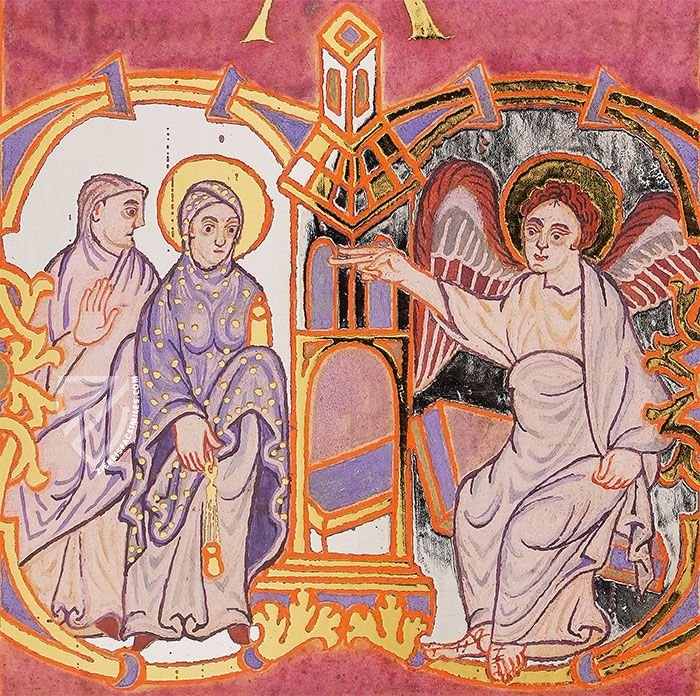
Gero-Codex
Presentation Miniature
Gero, the Archbishop of Cologne from 969 to 976, is depicted here presenting the manuscript to St. Peter. They are presented in a stylized church building, parts of which are adorned with silver and gold. Peter’s importance is indicated by his exaggerated size, brilliant golden halo, enthroned position, and avoidance of eye contact with Gero.
The first pope is depicted holding two scepters, but their meaning is unclear: some claim they spell out “Petr.” while others see them forming “FR” for Forum, a term for jurisdiction. The tonsured Gero looks humbly up at Peter and is dressed in priestly robes with a patterned stole hanging down to his feet. He us curiously depicted as though he were floating above the ground.
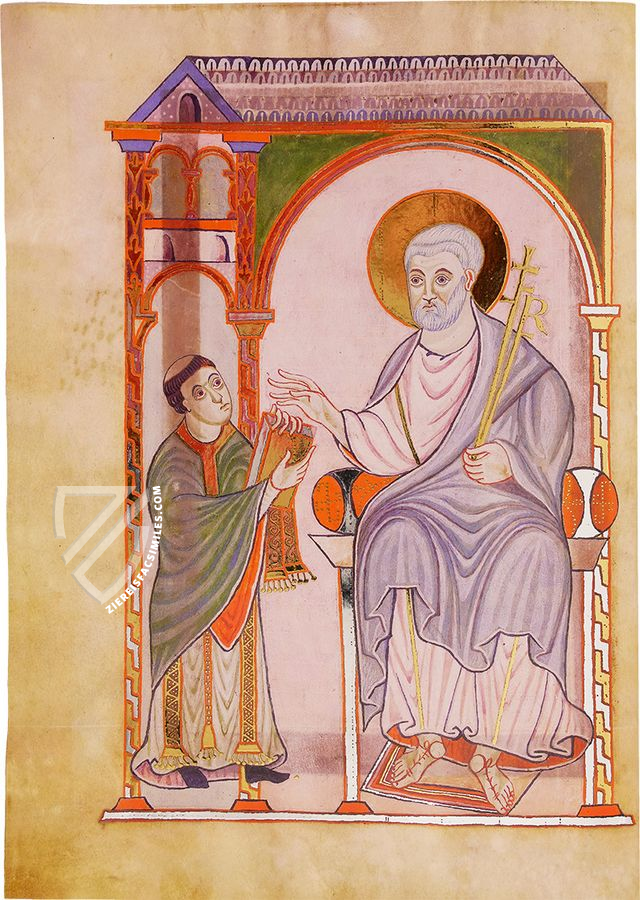
#1 Gero-Codex
Language: German
(over 10,000€)
- Treatises / Secular Books
- Apocalypses / Beatus
- Astronomy / Astrology
- Bestiaries
- Bibles / Gospels
- Chronicles / History / Law
- Geography / Maps
- Saints' Lives
- Islam / Oriental
- Judaism / Hebrew
- Single Leaf Collections
- Leonardo da Vinci
- Literature / Poetry
- Liturgical Manuscripts
- Medicine / Botany / Alchemy
- Music
- Mythology / Prophecies
- Psalters
- Other Religious Books
- Games / Hunting
- Private Devotion Books
- Other Genres
- Afghanistan
- Armenia
- Austria
- Belgium
- Belize
- Bosnia and Herzegovina
- China
- Colombia
- Costa Rica
- Croatia
- Cyprus
- Czech Republic
- Denmark
- Egypt
- El Salvador
- Ethiopia
- France
- Germany
- Greece
- Guatemala
- Honduras
- Hungary
- India
- Iran
- Iraq
- Israel
- Italy
- Japan
- Jordan
- Kazakhstan
- Kyrgyzstan
- Lebanon
- Liechtenstein
- Luxembourg
- Mexico
- Morocco
- Netherlands
- Palestine
- Panama
- Peru
- Poland
- Portugal
- Romania
- Russia
- Serbia
- Spain
- Sri Lanka
- Sweden
- Switzerland
- Syria
- Tajikistan
- Turkey
- Turkmenistan
- Ukraine
- United Kingdom
- United States
- Uzbekistan
- Vatican City
- A. Oosthoek, van Holkema & Warendorf
- Aboca Museum
- Ajuntament de Valencia
- Akademie Verlag
- Akademische Druck- u. Verlagsanstalt (ADEVA)
- Aldo Ausilio Editore - Bottega d’Erasmo
- Alecto Historical Editions
- Alkuin Verlag
- Almqvist & Wiksell
- Amilcare Pizzi
- Andreas & Andreas Verlagsbuchhandlung
- Archa 90
- Archiv Verlag
- Archivi Edizioni
- Arnold Verlag
- ARS
- Ars Magna
- ArtCodex
- AyN Ediciones
- Azimuth Editions
- Badenia Verlag
- Bärenreiter-Verlag
- Belser Verlag
- Belser Verlag / WK Wertkontor
- Benziger Verlag
- Bernardinum Wydawnictwo
- BiblioGemma
- Biblioteca Apostolica Vaticana (Vaticanstadt, Vaticanstadt)
- Bibliotheca Palatina Faksimile Verlag
- Bibliotheca Rara
- Boydell & Brewer
- Bramante Edizioni
- Bredius Genootschap
- Brepols Publishers
- British Library
- C. Weckesser
- Caixa Catalunya
- Canesi
- CAPSA, Ars Scriptoria
- Caratzas Brothers, Publishers
- Carus Verlag
- Casamassima Libri
- Centrum Cartographie Verlag GmbH
- Chavane Verlag
- Christian Brandstätter Verlag
- Circulo Cientifico
- Club Bibliófilo Versol
- Club du Livre
- CM Editores
- Collegium Graphicum
- Collezione Apocrifa Da Vinci
- Comissão Nacional para as Comemorações dos Descobrimentos Portugueses
- Coron Verlag
- Corvina
- CTHS
- D. S. Brewer
- Damon
- De Agostini/UTET
- De Nederlandsche Boekhandel
- De Schutter
- Deuschle & Stemmle
- Deutscher Verlag für Kunstwissenschaft
- DIAMM
- Droz
- E. Schreiber Graphische Kunstanstalten
- Ediciones Boreal
- Ediciones Grial
- Ediclube
- Edições Inapa
- Edilan
- Editalia
- Edition Deuschle
- Edition Georg Popp
- Edition Leipzig
- Edition Libri Illustri
- Editiones Reales Sitios S. L.
- Éditions de l'Oiseau Lyre
- Editions Medicina Rara
- Editorial Casariego
- Editorial Mintzoa
- Editrice Antenore
- Editrice Velar
- Edizioni Edison
- Egeria, S.L.
- Eikon Editores
- Electa
- Emery Walker Limited
- Enciclopèdia Catalana
- Eos-Verlag
- Ephesus Publishing
- Ernst Battenberg
- Eugrammia Press
- Extraordinary Editions
- Fackelverlag
- Facsimila Art & Edition
- Facsimile Editions Ltd.
- Facsimilia Art & Edition Ebert KG
- Faksimile Verlag
- Feuermann Verlag
- Folger Shakespeare Library
- Franco Cosimo Panini Editore
- Friedrich Wittig Verlag
- Fundación Hullera Vasco-Leonesa
- G. Braziller
- Gabriele Mazzotta Editore
- Gebr. Mann Verlag
- Gesellschaft für graphische Industrie
- Getty Research Institute
- Giovanni Domenico de Rossi
- Giunti Editore
- Graffiti
- Grafica European Center of Fine Arts
- Guido Pressler
- Guillermo Blazquez
- Gustav Kiepenheuer
- H. N. Abrams
- Harrassowitz
- Harvard University Press
- Helikon
- Hendrickson Publishers
- Henning Oppermann
- Herder Verlag
- Hes & De Graaf Publishers
- Hoepli
- Holbein-Verlag
- Houghton Library
- Hugo Schmidt Verlag
- Idion Verlag
- Il Bulino, edizioni d'arte
- ILte
- Imago
- Insel Verlag
- Insel-Verlag Anton Kippenberger
- Instituto de Estudios Altoaragoneses
- Instituto Nacional de Antropología e Historia
- Istituto dell'Enciclopedia Italiana - Treccani
- Istituto Ellenico di Studi Bizantini e Postbizantini
- Istituto Geografico De Agostini
- Istituto Poligrafico e Zecca dello Stato
- Italarte Art Establishments
- Jan Thorbecke Verlag
- Johnson Reprint Corporation
- Josef Stocker
- Josef Stocker-Schmid
- Jugoslavija
- Karl W. Hiersemann
- Kasper Straube
- Kaydeda Ediciones
- Kindler Verlag / Coron Verlag
- Kodansha International Ltd.
- Konrad Kölbl Verlag
- Kurt Wolff Verlag
- La Liberia dello Stato
- La Linea Editrice
- La Meta Editore
- Lambert Schneider
- Landeskreditbank Baden-Württemberg
- Leo S. Olschki
- Les Incunables
- Liber Artis
- Library of Congress
- Libreria Musicale Italiana
- Lichtdruck
- Lito Immagine Editore
- Lumen Artis
- Lund Humphries
- M. Moleiro Editor
- Maison des Sciences de l'homme et de la société de Poitiers
- Manuscriptum
- Martinus Nijhoff
- Maruzen-Yushodo Co. Ltd.
- MASA
- Massada Publishers
- McGraw-Hill
- Metropolitan Museum of Art
- Militos
- Millennium Liber
- Müller & Schindler
- Nahar - Stavit
- Nahar and Steimatzky
- National Library of Wales
- Neri Pozza
- Nova Charta
- Oceanum Verlag
- Odeon
- Orbis Mediaevalis
- Orbis Pictus
- Österreichische Staatsdruckerei
- Oxford University Press
- Pageant Books
- Parzellers Buchverlag
- Patrimonio Ediciones
- Pattloch Verlag
- PIAF
- Pieper Verlag
- Plon-Nourrit et cie
- Poligrafiche Bolis
- Presses Universitaires de Strasbourg
- Prestel Verlag
- Princeton University Press
- Prisma Verlag
- Priuli & Verlucca, editori
- Pro Sport Verlag
- Propyläen Verlag
- Pytheas Books
- Quaternio Verlag Luzern
- Reales Sitios
- Recht-Verlag
- Reichert Verlag
- Reichsdruckerei
- Reprint Verlag
- Riehn & Reusch
- Roberto Vattori Editore
- Rosenkilde and Bagger
- Roxburghe Club
- Salerno Editrice
- Saltellus Press
- Sandoz
- Sarajevo Svjetlost
- Schöck ArtPrint Kft.
- Schulsinger Brothers
- Scolar Press
- Scrinium
- Scripta Maneant
- Scriptorium
- Shazar
- Siloé, arte y bibliofilia
- SISMEL - Edizioni del Galluzzo
- Sociedad Mexicana de Antropología
- Société des Bibliophiles & Iconophiles de Belgique
- Soncin Publishing
- Sorli Ediciones
- Stainer and Bell
- Studer
- Styria Verlag
- Sumptibus Pragopress
- Szegedi Tudomànyegyetem
- Taberna Libraria
- Tarshish Books
- Taschen
- Tempus Libri
- Testimonio Compañía Editorial
- Thames and Hudson
- The Clear Vue Publishing Partnership Limited
- The Facsimile Codex
- The Folio Society
- The Marquess of Normanby
- The Richard III and Yorkist History Trust
- Tip.Le.Co
- TouchArt
- TREC Publishing House
- TRI Publishing Co.
- Trident Editore
- Tuliba Collection
- Typis Regiae Officinae Polygraphicae
- Union Verlag Berlin
- Universidad de Granada
- University of California Press
- University of Chicago Press
- Urs Graf
- Vallecchi
- Van Wijnen
- VCH, Acta Humaniora
- VDI Verlag
- VEB Deutscher Verlag für Musik
- Verlag Anton Pustet / Andreas Verlag
- Verlag Bibliophile Drucke Josef Stocker
- Verlag der Münchner Drucke
- Verlag für Regionalgeschichte
- Verlag Styria
- Vicent Garcia Editores
- W. Turnowski Ltd.
- W. Turnowsky
- Waanders Printers
- Wiener Mechitharisten-Congregation (Wien, Österreich)
- Wissenschaftliche Buchgesellschaft
- Wissenschaftliche Verlagsgesellschaft
- Wydawnictwo Dolnoslaskie
- Xuntanza Editorial
- Zakład Narodowy
- Zollikofer AG

